Toro 51638, 51653, 51911, 51912, 51916 Service Manual
...N-28 ENGINE SERVICE MANUAL
Table of Contents – Page 1 of 1
GENERAL INFORMATION
SPECIFICATIONS AND TORQUES
SAFETY WARNINGS AND NOTES
PRODUCT IDENTIFICATION NUMBERS
STARTING/STOPPING INSTRUCTIONS
SERVICE/MAINTENANCE INSTRUCTIONS
STORAGE INSTRUCTIONS
TROUBLESHOOTING ENGINE FAILS TO START
ENGINE STARVES ON ACCELERATION ENGINE IS HARD TO START
ENGINE STALLS
ENGINE FIRES INTERMITTENTLY
ENGINE DOES NOT PRODUCE MAXIMUM POWER CARBURETOR FLOODS
ENGINE STOPS AFTER RUNNING BRIEFLY ENGINE WILL NOT IDLE
ENGINE BACKFIRES OR MISFIRES
ENGINE WILL NOT ACCELERATE
ENGINE LACKS POWER OR STOPS DURING OPERATION
DISASSEMBLY, INSPECTION, & REPAIR
TYPICAL DISASSEMBLY SEQUENCE
MAJOR COMPONENTS (CONT.)
ENGINE
REASSEMBLY
TYPICAL DISASSEMBLY SEQUENCE
ENGINE
MAJOR COMPONENTS

GENERAL INFORMATION
General Information . . . . . . . . . . . . . . . . . . . . . . . . . . . . . . . . 1
Troubleshooting . . . . . . . . . . . . . . . . . . . . . . . . . . . . . .
Disassembly, Inspection, and Repair . . . . . . . . . . . . . . . . . . .
Reassembly . . . . . . . . . . . . . . . . . . . . . . . . . . . . . . . .
2
3
4
1 - 1

GENERAL INFORMATION
Table Of Contents
1
SPECIFICATIONS AND TORQUES
Engine - All N28 Engines . . . . . . . . . . . . . . . . . . . |
. . . 1-4 |
Engine - Units with Serial Number 102084332 to 302010968 |
. . . 1-4 |
Engine - Units with Serial Number 302010969 and Greater . |
. . . 1-3 |
Fuel and Lubrication . . . . . . . . . . . . . . . . . . . . . . |
. . . 1-4 |
Ignition . . . . . . . . . . . . . . . . . . . . . . . . . . . . . |
. . . 1-4 |
Air Filter . . . . . . . . . . . . . . . . . . . . . . . . . . . . |
. . . 1-5 |
Carburetor . . . . . . . . . . . . . . . . . . . . . . . . . . . |
. . . 1-5 |
Carburetor Units with Serial Number 102084332 to 302010968 |
. . 1-5 |
Carburetor Spacer . . . . . . . . . . . . . . . . . . . . . . . |
. . . 1-5 |
Clutch Standard N28 Engines . . . . . . . . . . . . . . . . . |
. . . 1-5 |
Clutch Professional N28 Engines . . . . . . . . . . . . . . . |
. . . 1-5 |
Crankcase and Cylinder . . . . . . . . . . . . . . . . . . . . |
. . . 1-5 |
Drive Housing (Boom) Professional N28 Units . . . . . . . . |
. . . 1-5 |
Engine/Styling Cover . . . . . . . . . . . . . . . . . . . . . |
. . . 1-5 |
Flex Drive Housing (Boom) - Standard N28 Units . . . . . . . |
. . . 1-5 |
Fuel Tank . . . . . . . . . . . . . . . . . . . . . . . . . . . |
. . . 1-5 |
Ignition Module . . . . . . . . . . . . . . . . . . . . . . . . |
. . . 1-5 |
Muffler . . . . . . . . . . . . . . . . . . . . . . . . . . . . . |
. . . 1-5 |
Starter/Starter Housing . . . . . . . . . . . . . . . . . . . . |
. . . 1-5 |
1 - 2

GENERAL INFORMATION
1
Safety Warnings and Notes . . . . . . . . . . . . . . . . . . . . . . . . |
1-6 |
Product Identification Numbers . . . . . . . . . . . . . . . . . . . . . . |
1-7 |
Engine Serial Number Significance . . . . . . . . . . . . . . . . . |
1-7 |
Oil and Fuel Recommendations . . . . . . . . . . . . . . . . . . . . . . |
1-7 |
Recommended Oil Type . . . . . . . . . . . . . . . . . . . . . . |
1-7 |
Recommended Fuel Type . . . . . . . . . . . . . . . . . . . . . |
1-7 |
Use of Blended Fuels . . . . . . . . . . . . . . . . . . . . . . . |
1-8 |
Problems with Blended Fuels . . . . . . . . . . . . . . . . . . . . |
1-8 |
Gasohol Use May Require Carburetor Adjustments . . . . . . . . |
1-8 |
Use of Fuel Additives . . . . . . . . . . . . . . . . . . . . . . . . |
1-8 |
Fuel and Oil Mixing Instructions . . . . . . . . . . . . . . . . . . |
1-8 |
Starting/Stopping Instructions . . . . . . . . . . . . . . . . . . . . . . . |
1-9 |
To Start the Engine . . . . . . . . . . . . . . . . . . . . . . . . . |
1-9 |
To Stop the Engine . . . . . . . . . . . . . . . . . . . . . . . . . |
1-9 |
Service/Maintenance Instructions . . . . . . . . . . . . . . . . . . . . . |
1-10 |
Air Filter . . . . . . . . . . . . . . . . . . . . . . . . . . . . . . . |
1-10 |
Spark Plug . . . . . . . . . . . . . . . . . . . . . . . . . . . . . |
1-10 |
Carburetor Adjustment . . . . . . . . . . . . . . . . . . . . . . . |
1-11 |
Governed Carburetor Check . . . . . . . . . . . . . . . . . . . . |
1-12 |
Storage Instructions . . . . . . . . . . . . . . . . . . . . . . . . . . . . |
1-13 |
Storage for 45 to 60 Days . . . . . . . . . . . . . . . . . . . . . |
1-13 |
Storage for More Than 60 Days . . . . . . . . . . . . . . . . . . |
1-13 |
Reactivate Unit for Service . . . . . . . . . . . . . . . . . . . . . |
1-13 |
Special Tools . . . . . . . . . . . . . . . . . . . . . . . . . . . . . . . . |
1-13 |
1 - 3
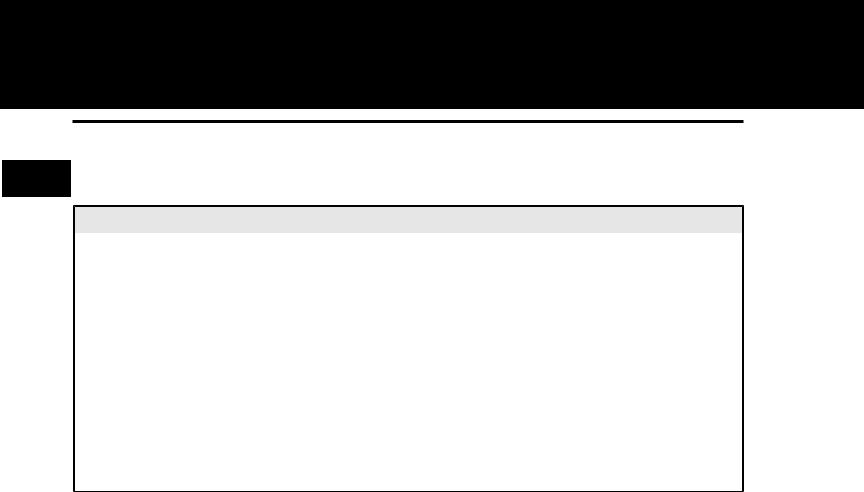
GENERAL INFORMATION
SPECIFICATIONS AND TORQUES
1 Engine Specifications
Item
Engine Type |
Air-cooled. 2-cycle, Third Port |
|
|
Displacement |
1.7 cu. in. (28.5 cc) |
|
|
Bore 1.31 in. (33.27 mm) |
1.31 in. (33.27 mm) |
|
|
Stroke 1.28 in. (32.51 mm) |
1.28 in. (32.51 mm) |
|
|
Average Compression |
115-125 lbs. (52-57 kg) |
|
|
Piston Ring(s) Side Clearance |
0.004 in. max (0.101 mm) |
|
|
Piston Ring Width (S/N 102084332 to 302010968) |
0.060 in. (1.6 mm) |
|
|
Piston Ring Width (S/N 302010969 and Greater) |
0.046 in. (1.14 mm) |
|
|
Piston Ring End Gap (S/N 102084332 to 302010968) |
0.072 in. (1.8 mm) |
|
|
Piston Ring End Gap (S/N 302010969 and Greater) |
0.057 in. (1.45 mm) |
|
|
Fuel and Lubrication
Item |
|
Lubrication |
Fuel/Oil Mixture |
|
|
Fuel/Oil Ratio |
32:1 |
|
|
Approx. Fuel Tank Capacity |
18 oz. (530 ml) |
|
|
|
|
Ignition
Item |
|
Ignition Type |
Electronic |
|
|
Ignition Module Air Gap |
0.010-0.015 in. (0.254-0.381 mm) |
|
|
Spark Plug Type |
Champion® RDJ7Y |
|
|
Spark Plug Gap |
0.018-0.023 in. (0.45 to 0.58 mm) |
|
|
|
|
1 - 4
|
|
GENERAL INFORMATION |
|
|
|
|
|
|
|
|
|
|
|
|
|
SPECIFICATIONS AND TORQUES (cont.) |
|
|
|
|
|
|
|
|
|
Torque Specifications |
|
1 |
|
|
|
|
|
|
|
Item |
|
|
|
|
Air Filter Cover Mounting Screws |
18-22 in•lb (2.0-2.5 N•m) |
|
|
|
|
|
|
|
|
Carburetor/Choke Plate Mounting Screws (Initial Torque) |
13-17 in•lb (1.5-1.9 N•m) |
|
|
|
|
|
|
|
|
Carburetor/Choke Plate Mounting Screws (Retorque) |
23-27 in•lb (2.6-3.0 N•m) |
|
|
|
|
|
|
|
|
Throttle Wire Swivel Screw (S/N 102084332 to |
9-12 in•lb (1.0-1.4 N•m) |
|
|
|
302010968) |
|
|
|
|
|
|
|
|
|
Carburetor Spacer Screws |
55-65 in•lb (6.2-7.3 N•m) |
|
|
|
|
|
|
|
|
Clutch Cover Mounting Screws |
35-40 in•lb (3.9-4.5 N•m) |
|
|
|
|
|
|
|
|
Clutch Rotor |
150-160 in•lb (16.9-18.0 N•m) |
|
|
|
|
|
|
|
|
Clutch Housing/Drum Assembly Screws |
35-40 in•lb (3.9-4.5 N•m) |
|
|
|
|
|
|
|
|
Clutch Rotor |
130-150 in•lb (14.6-16.8 N•m) |
|
|
|
|
|
|
|
|
Clutch Bolts |
60-80 in•lb (6.7-9.0 N•m) |
|
|
|
|
|
|
|
|
Crankcase (Cylinder) Mounting Screws |
50-60 in•lb (5.6-6.7 N•m) |
|
|
|
|
|
|
|
|
Crankcase Cover Mounting Screws |
55-65 in•lb (6.2-7.3 N•m) |
|
|
|
|
|
|
|
|
Spark Plug |
100-120 in•lb (11.2-13.5 N•m) |
|
|
|
|
|
|
|
|
Boom Clamp Screw |
70-80 in•lb (7.9-9.0 N•m) |
|
|
|
|
|
|
|
|
Anti-Rotation Screw |
15-20 in•lb (1.7-2.3 N•m) |
|
|
|
|
|
|
|
|
Rear Engine Cover to Starter Housing Screw |
50-60 in•lb (5.6-6.7 N•m) |
|
|
|
|
|
|
|
|
Rear Engine Cover to Crankcase Screw |
35-40 in•lb (3.9-4.5 N•m) |
|
|
|
|
|
|
|
|
Engine Styling Cover |
35-40 in•lb (3.9-4.5 N•m) |
|
|
|
|
|
|
|
|
Boom Clamp Nut |
70-80 in•lb (7.9-9.0 N•m) |
|
|
|
|
|
|
|
|
Anti-Rotation Screw |
15-20 in•lb (1.7-2.3 N•m) |
|
|
|
|
|
|
|
|
Fuel Tank Bracket Screws |
50-60 in•lb (5.6-6.7 N•m) |
|
|
|
|
|
|
|
|
Ignition Module Mounting Screws |
25-35 in•lb (2.8-3.9 N•m) |
|
|
|
|
|
|
|
|
Muffler Exhaust Tube Screws |
15-25 in•lb (1.7-2.8 N•m) |
|
|
|
|
|
|
|
|
Muffler Mounting Screws |
80-90 in•lb (9.0-10.1 N•m) |
|
|
|
|
|
|
|
|
Starter Housing Screws |
35-40 in•lb (3.9-4.5 N•m) |
|
|
|
|
|
|
|
|
Starter Pulley Retainer Screw |
20-30 in•lb (2.3-3.4 N•m) |
|
|
|
|
|
|
|
|
|
|
|
|
1 - 5

GENERAL INFORMATION
SAFETY WARNINGS AND NOTES
The purpose of safety symbols is to attract your
1 attention to possible dangers. The safety symbols and the explanations with them deserve your careful attention and understanding. The safety warnings do not by themselves eliminate any danger. The instructions or warnings they give are not substitutes for proper accident prevention measures.
WARNING: |
For Your Safety |
Highlights instructions which failure to obey can result in personal injury.
NOTE: Advises of information which may be useful while performing maintenance or repair of the equipment. Also highlights instructions which failure to obey can result in damage to parts or equipment.
WARNING: |
Spring Under Tension! |
The rope starter on these engines contains a flat wire spring that is under tension. Wear eye and hand protection when replacing worn or broken spring, in case it should uncoil as it is handled. Allow spring tension to be completely relieved and make sure pulley disengages from spring before removing the pulley retainer(s), pulley, and starter spring from housing.
WARNING: Electrical Shock!
Never touch electrical wires or components while the engine is running. They can be sources of electrical shock.
WARNING: HOT SURFACES!
The muffler, cylinder, crankcase, trimmer cutting head, and other engine surfaces get extremely hot from operation. These surfaces remain hot for a short period of time after the engine is stopped. To prevent severe burns, allow the engine to cool completely before servicing.
WARNING: Explosive Fuel!
Gasoline may be present in the fuel tank, carburetor, fuel line, or crankcase. Gasoline is extremely flammable and its vapors can explode if ignited. Keep sparks, flames, and other sources of ignition away from the engine. Do not smoke while servicing the engine. Never use gasoline as a cleaning agent.
Store gasoline only in approved containers in well-ventilated, unoccupied buildings away from sparks, flames, or other sources of ignition. Do not fill the fuel tank while the engine is hot or running, since spilled fuel could ignite if it comes in contact with hot parts or sparks from ignition. Do not start the engine near spilled fuel. Do not smoke while handling gasoline or filling the fuel tank.
WARNING: |
Cracked or Broken FLYWHEEL |
|
Cooling Fins Are A Hazard! |
Be careful not to crack or break any flywheel cooling fins. They could fly off during operation. If cooling fins are cracked or broken, replace the flywheel.
1 - 6
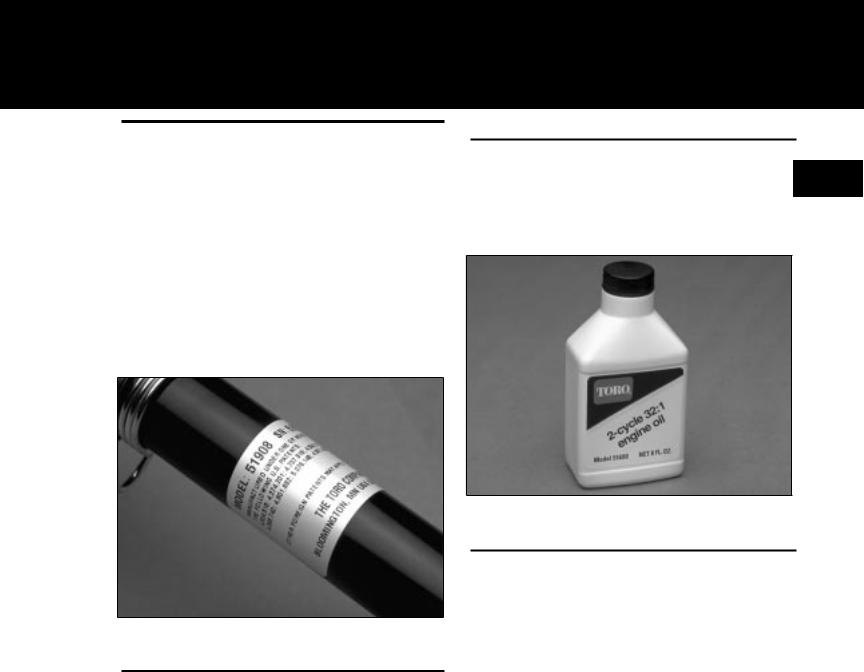
PRODUCT IDENTIFICATION NUMBERS
When ordering parts, or in any communication involving an engine or product, always give the:
•Model Number and
•Serial Number
These numbers are located on a decal (or decals) affixed to the unit (Figure 1-1). The identification decal(s) will be located on the engine, metal boom, or plastic housing. The actual location will vary depending on the type of product.
Figure 1-1. Product Identification Decal.
OIL AND FUEL
RECOMMENDATIONS
WARNING: Explosive Fuel!
Gasoline is extremely flammable and its vapors can explode if ignited. Store gasoline only in approved containers in well-ventilated, unoccupied buildings away from sparks or flames. Do not fill the tank while the engine is hot or running, since spilled fuel could ignite if it comes in contact with hot parts or sparks from ignition. Do not start the engine near spilled fuel. Do not smoke while handling gasoline. Never use gasoline as a cleaning agent.
NOTE: READ THESE INSTRUCTIONS CAREFULLY BEFORE ATTEMPTING TO START OR OPERATE THIS UNIT. Using old oil or fuel or improperly mixing the oil and fuel can cause engine damage. This type of damage will void the engine warranty.
GENERAL INFORMATION
Recommended Oil Type
Toro 2-cycle oil is recommended for use in these
engines (Figure 1-2). If another brand of 2-cycle oil is 1 used, use a high quality oil that is formulated for small 2-cycle air-cooled engines.
Figure 1-2. Recommended Oil Type.
Recommended Fuel Type
Use clean fresh, regular grade unleaded gasoline.
NOTE: Alcohol blended fuel absorbs moisture (water). As little as 1% moisture in the fuel can cause fuel and oil to separate and form acids when stored.
If these types of fuel must be used, use fresh fuel (less than 60 days old) and mix according to the instructions in this section.
1 - 7
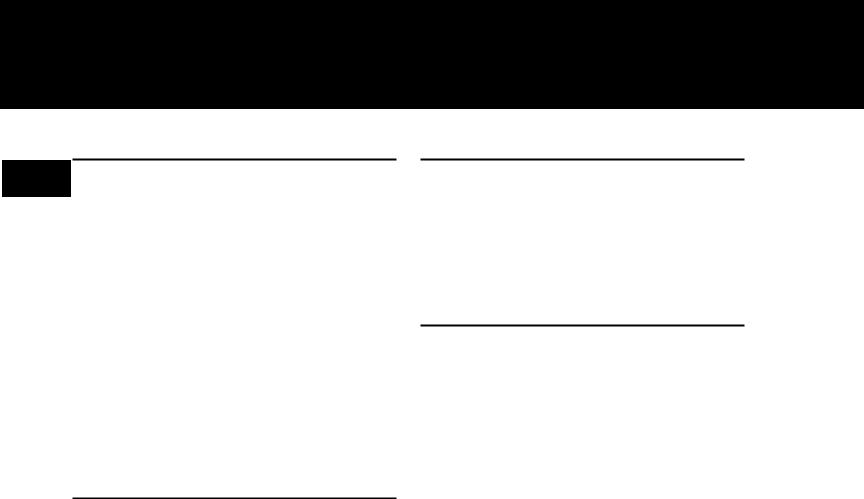
GENERAL INFORMATION
Use of Blended Fuels
1 If you choose to use a blended fuel or its use is unavoidable, the following precautions are recommended:
1.Always use fresh fuel mixed according to the instructions in this section.
2.Use the special additive Alcohol Protector® (by Gold Eagle) or equivalent to inhibit corrosion and reduce oil/fuel separation (mix as directed).
3.Always agitate the fuel mix before fueling unit.
4.Drain the fuel tank and run engine dry before storing unit.
Problems with Blended Fuels
Some problems associated with blended fuels include:
•Vapor lock
•Poor warm restart
•Poor performance at high altitudes
•Corrosion of fuel system components
If any of these symptoms occur, switch to regular, unleaded gasoline.
Gasohol Use May Require Carburetor Adjustments
These engines are lubricated by oil mixed with fuel. Using blended fuel may alter the air/fuel ratio causing a lean mix (less fuel, more air).
If this condition is not corrected by adjusting the carburetor, engine damage due to poor lubrication can result.
Use of Fuel Additives
The use of fuel additives such as Toro Gas Stabilizer/Conditioner, STA-BIL® Gas Stabilizer, or an equivalent, will minimize the formation of fuel gum deposits. Such an additive should only be used when fuel/oil mix is prepared. Add 0.4 oz. (11 ml) per gallon of gasoline or mix per instructions on container. NEVER add fuel additives directly to the unit fuel tank.
Fuel and Oil Mixing Instructions
NOTE: For proper engine operation and maximum reliability, pay strict attention to these fuel and oil mixing instructions. Use a 32:1 fuel/oil ratio when using Toro or IDC 2-cycle oil. Using improperly mixed fuel can severely damage the engine. Never mix the gasoline and oil in the fuel tank of the unit.
Use the following procedures to ensure complete mixing:
1.Put a small amount of fresh gasoline into a clean one U.S. gallon (3.785 liter) fuel can.
2.Add 4-oz. (118 ml) of Toro 2-cycle engine oil.
3.Fill the remainder of the fuel can with gasoline.
4.Screw the fuel can cap on tightly and SHAKE THE CAN VIGOROUSLY FOR 30 SECONDS.
1 - 8
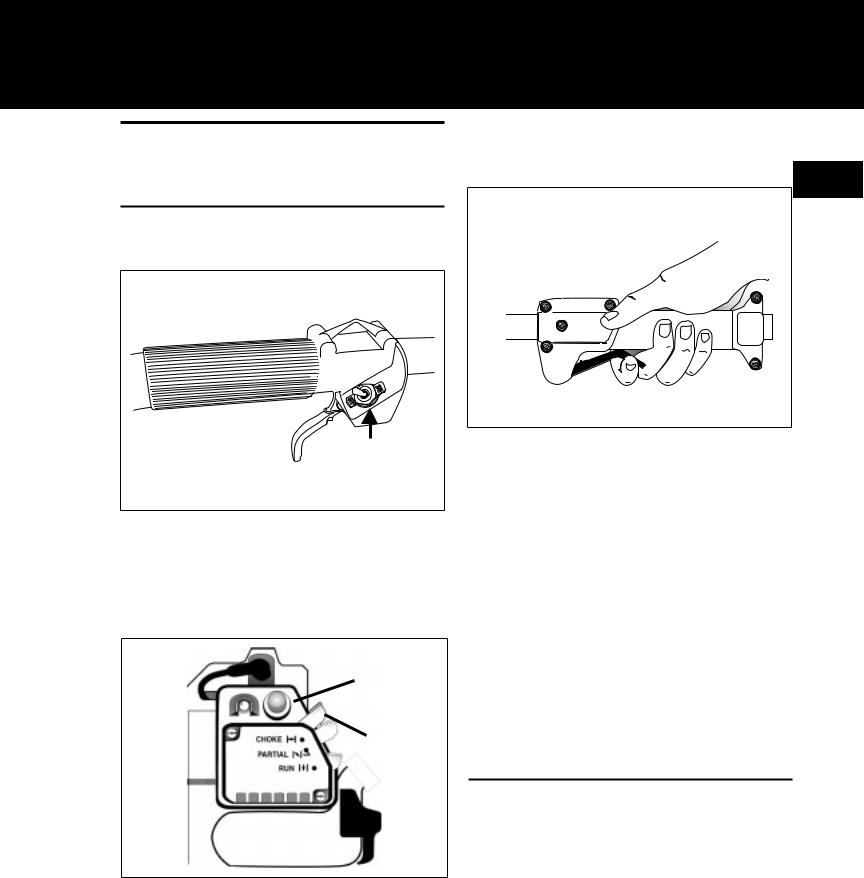
GENERAL INFORMATION
STARTING/STOPPING
INSTRUCTIONS
To Start the Engine
1.Make sure the switch is in the “START” or “ON” position (Figure 1-3).
Figure 1-3. Typical Ignition Switch. |
3.6069.003. |
|
2.FULLY PRESS AND RELEASE the primer bulb 5 to 7 times (Figure 1-4).
3.Place the choke lever in the FULL “CHOKE” position (Figure 1-4).
Primer Bulb
Choke Lever
Figure 1-4. Primer Bulb and Choke Lever. |
3.6069.004 |
|
4.Place the unit in the starting position with the trimmer cutting head away from yourself and others.
5. Squeeze the throttle trigger to “FULL THROTTLE” |
|
|
(Figure 1-5). Hold or lock the throttle in this |
|
1 |
position. |
|
|
|
|
|
Figure 1-5. Typical Throttle Control. |
3.6069.005 |
|
|
|
|
6.Pull the starter rope BRISKLY until you hear the engine sound like it wants to run (normally 2 to 5 pulls).
7.Place the choke lever in the “PARTIAL” choke position (Figure 1-4).
8Pull the starter rope BRISKLY 1 to 3 pulls to start the engine.
9.If the engine does not start, repeat steps 1 through 8.
10.After the engine warms up for 5 to 10 seconds, place the choke lever in the “RUN” position.
To Stop the Engine
Place the ignition switch in the “OFF” or “STOP” position (see Figure 1-3).
1 - 9

GENERAL INFORMATION
SERVICE/MAINTENANCE INSTRUCTIONS
1
Air Filter
NOTE: CLEAN AND RE-OIL THE AIR FILTER EVERY 10 HOURS OF OPERATION. The air filter is one of the most important areas to maintain. If it is not maintained as follows, severe engine damage can result:
1Remove the air filter from the carburetor/air filter cover assembly. Refer to Part 3 - Engine Disassembly.
2.Wash the air filter in detergent and water
(Figure 1-6). Rinse the air filter thoroughly in clean water and allow it to dry.
3.6069.008
Figure 1-7. Oiling Air Filter Element.
4.Squeeze the air filter to ensure that the oil is spread throughout the entire filter (Figure 1-8).
Figure 1-6. Washing Air Filter Element. |
3.6069.006 |
|
3. Apply clean SAE 30 oil to the air filter (Figure 1-7).
Figure 1-8. Squeezing Excess Oil from Air |
3.6069.008 |
|
|
Filter Element. |
|
5.Reinstall the air filter in the carburetor/air filter cover assembly. Refer to Part 4 - Engine Assembly.
Spark Plug
Every 50 hours of operation remove the spark plug, check its condition, and reset the gap or replace with a new plug as necessary.
WARNING: Electrical Shock!
1 - 10
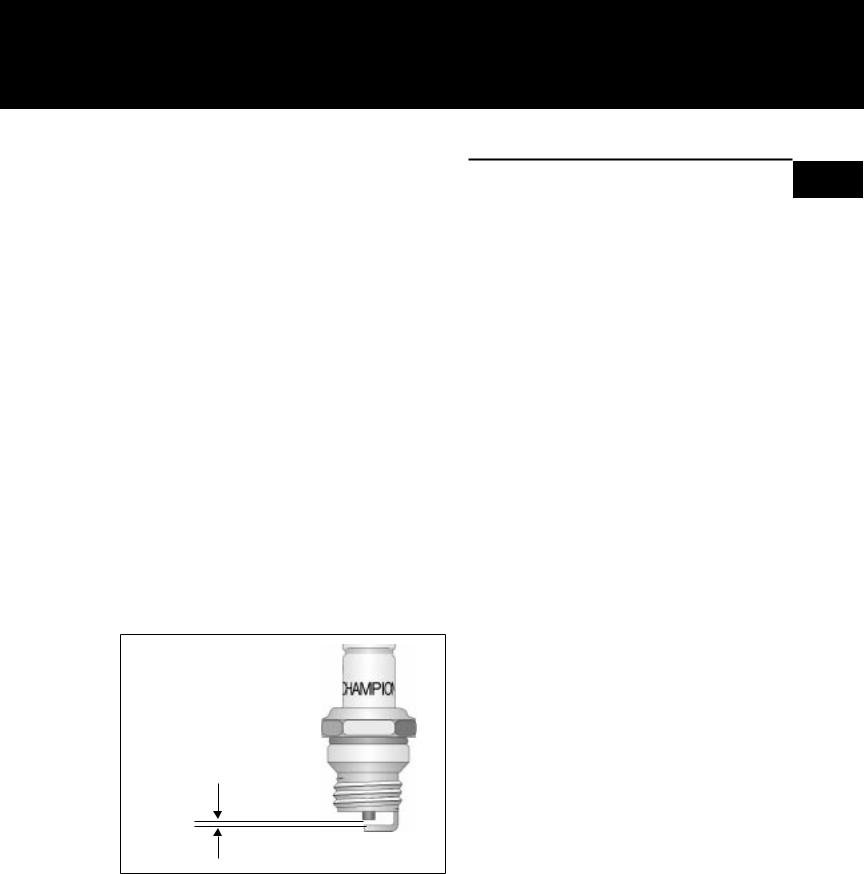
GENERAL INFORMATION
Never touch electrical wires or components while the engine is running. They can be sources of electrical shock.
1.Before removing the spark plug, clean the area around the base of the spark plug to keep dirt and debris out of the engine.
2.Disconnect the spark plug wire and remove the spark plug from engine.
3.Inspect the spark plug for carbon buildup and clean if necessary. Replace the plug if it is badly burnt or if reuse is questionable.
NOTE: Do not clean the spark plug in a machine which uses abrasive grit. Some grit could remain on the spark plug and enter the engine causing extensive damage.
4.Check the spark plug gap using a wire feeler gauge. Set the gap to 0.018-0.023 inch (0.45 to 0.58 mm) (Figure 1-9).
5.Reinstall the spark plug and torque to 100-120 in•lb (11.3 - 13.5 N•m).
0.018 - 0.023 in.
(0.45 - 0.58 mm)
Carburetor Adjustment |
|
These engines are equipped with a diaphragm-type |
1 |
carburetor. The carburetor has been carefully calibrated at the factory. In most cases, no further adjustment will be required.
The condition of the air filter is very important to the operation of the trimmer. A dirty air filter will restrict the air flow to the carburetor. This, in turn, upsets the fuel-air mixture in the carburetor. The resulting symptoms are often mistaken for an out-of-adjustment carburetor. Therefore, check the condition of the air filter before adjusting the carburetor. Refer to “Air Filter” Service/Maintenance Instructions.
If the following conditions are experienced, it may be necessary to adjust the carburetor:
•The engine will not idle.
•The engine hesitates or stalls on acceleration.
•The loss of engine power, which is not corrected by cleaning the air filter.
•The engine operates in an erratic or fuel-rich condition (indicated by excessive exhaust smoke from the muffler).
NOTE: Follow these carburetor adjustment procedures carefully. An incorrectly adjusted carburetor can cause severe engine damage.
Make sure the unit is fully assembled before making carburetor adjustments.
For trimmers and brushcutters, make sure the boom, cutting head, and line guard are installed and the cutting line is extended to its full cutting length.
The carburetor has three basic adjustments: idle speed adjustment, idle mixture adjustment, and high speed mixture adjustment (Figure 1-10).
Figure 1-9. Spark Plug Gap. |
3.6069.009 |
|
1 - 11
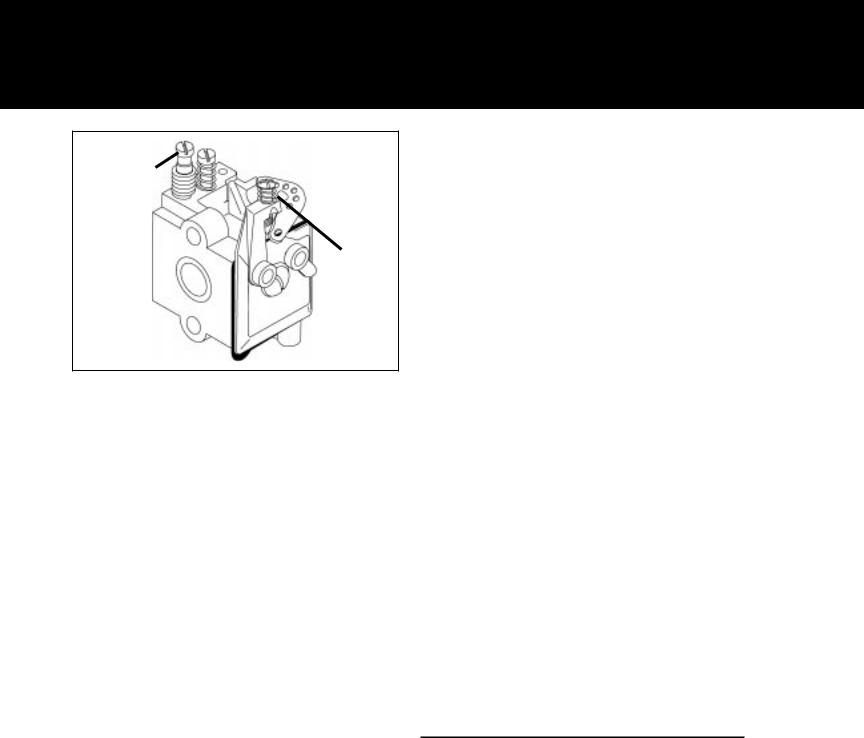
GENERAL INFORMATION
|
(H) High |
|
(L) Idle Mixture |
|
|
||
1 |
Speed |
|
Needle |
Mixture |
|
|
Idle
Speed
Screw
5.Final High Speed Mixture Setting: Squeeze the throttle trigger to the FULL (WIDE OPEN) THROTTLE position. Turn the high speed mixture needle clockwise or counterclockwise to set the high speed RPM: 6,800 to 7,200.
6.Release the throttle trigger and let the engine idle. If the engine stops, turn the idle speed screw clockwise 1/8 turn at a time until the engine idles.
7.Final Idle Mixture and Idle Speed Settings: Adjust the the idle mixture and idle speed as follows:
Figure 1-10. Carburetor Adjustments. |
3.6069.010 |
|
1.Initial Idle Speed Setting: Turn idle speed screw counterclockwise until it does not touch the throttle lever. Now turn the screw clockwise until it just touches the throttle lever; then continue turning 2 full turns.
2.If so equipped, remove the rubber cap from the high speed mixture adjustment needle.
3.Initial High Speed Mixture and Idle Mixture Settings: Turn both the high speed mixture and idle mixture needles clockwise until they are lightly seated. Then turn the needles counterclockwise the following number of turns:
High Speed Mixture Needle : |
1¼ turns |
Idle Mixture Needle: |
1¼ turns |
NOTE: Turn the high speed mixture and idle mixture needles finger-tight. Do not force the needles with a screw driver as this can damage the tips of the needles and the seats in the carburetor body.
4.Start engine and allow it to warm up for 3 to 5 minutes.
NOTE: For the following steps, use a magnetic pick-up 2-cycle engine tachometer to monitor engine speed.
a.Turn the idle mixture needle clockwise until the fastest idle RPM is reached; then turn the needle counterclockwise 1/8 turn.
b.Squeeze the throttle trigger. If the engine falters or hesitates as it accelerates, turn the idle mixture needle counterclockwise 1/16 turn at
a time until the engine accelerates rapidly.
c.If the idle speed has changed significantly because of steps a. and b. above, readjust the idle speed screw.
The recommended idle speed for all products is 3,000 to 3,200 RPM.
8.Make sure the air filter cover is reinstalled securely before placing the unit back into service.
Governed Carburetor Check
Some units are equipped with fuel-governed carburetors. If so equipped, and after adjusting the carburetor, check the operation of the governor on trimmers and brush cutters as follows:
1.Clip or wind the cutting line so it is inside the cutting head (not extended to its full cutting length).
2.Start the engine and run it at FULL (WIDE OPEN) THROTTLE.
The maximum high speed RPM should not exceed 8,800 RPM.
1 - 12

GENERAL INFORMATION
3.If the high speed RPM exceeds 8,800 RPM, the governor assembly in the carburetor must be cleaned or replaced and the carburetor readjusted.
STORAGE INSTRUCTIONS
WARNING: Explosive Fuel!
Gasoline is extremely flammable and its vapors can explode if ignited. Store gasoline only in approved containers in well-ventilated, unoccupied buildings away from sparks or flames. Do not fill the fuel tank while the engine is hot or running, since spilled fuel could ignite if it comes in contact with hot parts or sparks from ignition. Do not start the engine near spilled fuel. Do not smoke while handling gasoline. Never use gasoline as a cleaning agent.
Storage for 45 to 60 Days
Use the following storage procedure for equipment or fuel that will be stored for more than 45 days and less than 60 days:
Equipment - Empty the fuel tank and run the unit until the fuel system is empty. When starting the unit after storage, refill the fuel tank with freshly mixed gasoline and oil.
Fuel - Do not use fuel that has been stored for more than 60 days. Dispose the old fuel in a safe manner and use a fresh mix.
Storage for More Than 60 Days
1.Drain all fuel from the fuel tank into an approved fuel container.
2.Start the engine and run it until it stalls.
3.Allow the engine to cool. Remove the spark plug and put about 1 oz. (39 ml) of any high quality motor or 2-cycle oil into the cylinder. Pull the starter rope slowly to distribute the oil. Reinstall the spark plug.
4.Clean the unit and inspect for any loose or damaged parts. Repair or replace damaged parts and tighten loose screws, nuts, or bolts.
5. Store the unit in a dry, well ventilated area.
To Reactive Unit for Service |
1 |
|
|
|
|
1.Remove the spark plug and drain the oil from the cylinder by slowly pulling the starter rope.
2.Reinstall the spark plug.
3.Refuel the unit with a fresh gasoline/oil mixture. Start engine in accordance with the Starting Instructions.
SPECIAL TOOLS
In addition to typical hand tools, the following special tools are required to properly service these engines:
•Clutch Tool, (Standard N28 Engines) P/N 147337 (Figure 1-11).
•Clutch Tool, (Professional N28 Engines) (Figure 1 -12).
•Flywheel Holder, P/N 612470 (Figure 1- 13).
•0-250 in•lb (0-28.1 N•m) Torque Wrench (commercially available).
•Torx® Screwdriver or Bit Set (commercially available).
•Two-stroke, Magnetic Pick-up Tachometer (commercially available).
•Arbor or Hydraulic Press (commercially available).
•Bearing and Seal Pullers (commercially available).
•Hex Wrench Clutch Rotor Tool, P/N 180918.
•Flywheel Holding Tool, P/N 180918.
•0-250 in•lb (0-28.1 N•m) Torque Wrench (commercially available).
•Torx® Screwdriver or Bit Set (commercially available).
•Two-stroke, Magnetic Pick-up Tachometer (commercially available).
1 - 13
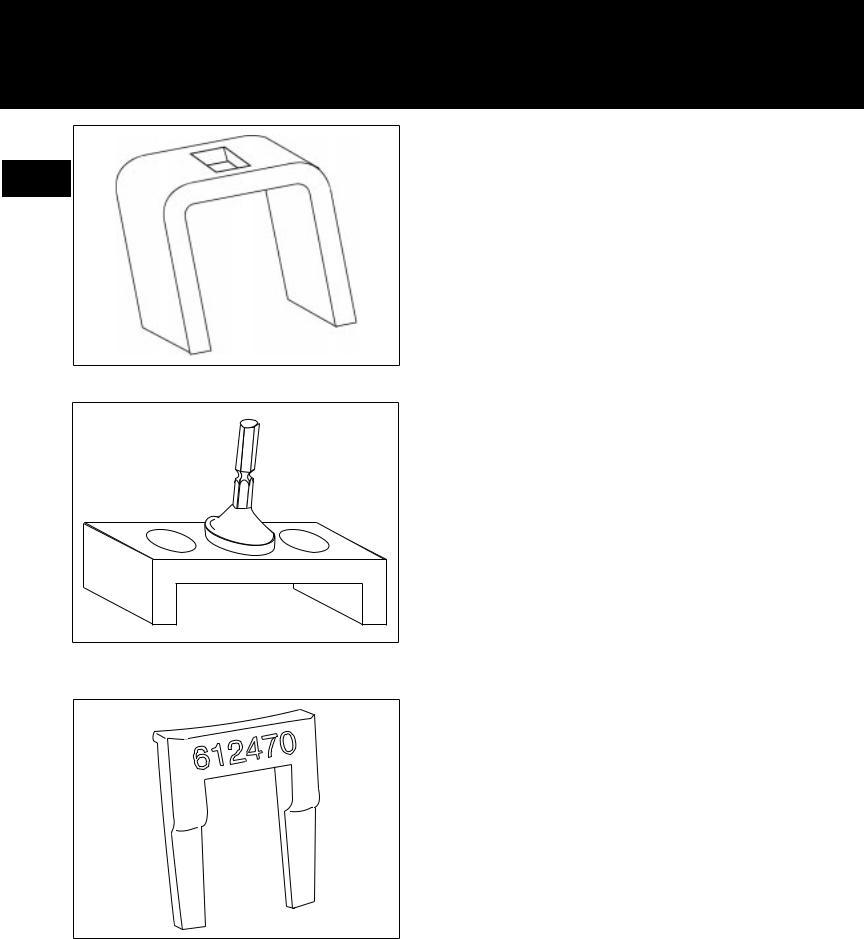
GENERAL INFORMATION
1
Figure 1-11. |
Clutch Tool P/N 147337. |
3.6069.011 |
|
3.6069.012
Figure 1-12. Clutch Tool for Professional N28 Engines.
Figure 1-13. Flywheel Holder, P/N 612470. |
3.6069.013 |
|
1 - 14

TROUBLESHOOTING
General Information . . . . . . . . . . . . . . . . . . . . . . . . . . . . . . . . . 1
Troubleshooting . . . . . . . . . . . . . . . . . . . . . . . . . . . . . |
2 |
Disassembly, Inspection, and Repair . . . . . . . . . . . . . . . . . . . |
3 |
Reassembly . . . . . . . . . . . . . . . . . . . . . . . . . . . . . . . . |
4 |
2 - 1

TROUBLESHOOTING
Table of Contents
|
Engine Fails to Start . . . . . . . . . . . . . . . . . . . . . . . . . . . . |
2-3 |
|
Engine Starves on Acceleration . . . . . . . . . . . . . . . . . . . . . . |
2-4 |
|
Engine is Hard to Start . . . . . . . . . . . . . . . . . . . . . . . . . . . |
2-4 |
2 |
Engine Stalls . . . . . . . . . . . . . . . . . . . . . . . . . . . . . . . . |
2-4 |
|
Engine Fires Intermittently . . . . . . . . . . . . . . . . . . . . . . . . . |
2-5 |
|
Engine Does Not Produce Maximum Power . . . . . . . . . . . . . . . . |
2-5 |
|
Carburetor Floods . . . . . . . . . . . . . . . . . . . . . . . . . . . . . |
2-5 |
|
Engine Stops After Running Briefly . . . . . . . . . . . . . . . . . . . . . 2-6 |
|
|
Engine Will Not Idle . . . . . . . . . . . . . . . . . . . . . . . . . . . . . 2-6 |
|
|
Engine Backfires or Misfires . . . . . . . . . . . . . . . . . . . . . . . . |
2-6 |
|
Engine Will Not Accelerate . . . . . . . . . . . . . . . . . . . . . . . . . 2-7 |
|
|
Engine Lacks Power or Stops During Operation . . . . . . . . . . . . . . |
2-7 |
2 - 2

TROUBLESHOOTING
When difficulties occur, be sure to check for simple causes which, at first, may seem too obvious to beconsidered. A starting problem, for example, could be caused by an empty fuel tank.
The following table lists some common causes of operating troubles and the possible causes and remedies.
Engine Fails to Start
|
|
2 |
|
Possible Cause |
Remedy |
||
|
|||
Ignition switch OFF |
Turn switch ON |
|
|
|
|||
|
|
|
|
Out of fuel or water in fuel |
Drain tank and blow out fuel lines to remove |
|
|
|
water. Refuel tank with fresh fuel mixture. |
|
|
|
|
|
|
Dirty or plugged air filter |
Clean or replace air filter |
|
|
|
|
|
|
Loose spark plug lead wire |
Reconnect lead wire |
|
|
|
|
|
|
Fouled, improperly gapped, or broken spark plug |
Clean or replace spark plug; set gap to |
|
|
|
0.018-0.023 inch (0.45 to 0.58 mm) |
|
|
|
|
|
|
Plugged fuel tank cap vent |
Clean fuel tank cap vent |
|
|
|
|
|
|
Plugged or waterlogged fuel filter |
Replace fuel filter |
|
|
|
|
|
|
Improperly adjusted carburetor |
Adjust carburetor |
|
|
|
|
|
|
Plugged muffler |
Clean or replace muffler |
|
|
|
|
|
|
Faulty primer or primer/fuel lines improperly installed |
Correctly install primer/fuel lines or |
|
|
|
replace primer |
|
|
|
|
|
|
Incorrect fuel mixture |
Drain tank; refill with correct fuel mixture |
|
|
|
|
|
|
Plugged fuel line |
Blow out fuel line |
|
|
|
|
|
|
Faulty carburetor diaphragm |
Replace diaphragm |
|
|
|
|
|
|
Plugged fuel pump filter screen |
Clean or replace filter screen |
|
|
|
|
|
|
Faulty fuel pump diaphragm |
Replace pump diaphragm |
|
|
|
|
|
|
Plugged carburetor/fuel pump passages |
Clean out passages |
|
|
|
|
|
|
Incorrect air gap between flywheel and ignition |
Set ignition module air gap to |
|
|
|
(0.010-0.015 in (0.254-0.381 mm) |
|
|
|
|
|
|
Faulty ignition module |
Replace ignition module |
|
|
|
|
|
|
Low compression |
Replace piston ring(s) or cylinder |
|
|
|
|
|
|
|
|
|
2 - 3

TROUBLESHOOTING
Engine Starves on Acceleration
Possible Cause |
Remedy |
Plugged fuel filter |
Replace fuel filter |
|
|
Improperly adjusted carburetor |
Adjust carburetor about 1/8 turn |
|
|
|
|
2 Engine is Hard to Start
Possible Cause |
Remedy |
Fouled, improperly gapped, or broken spark plug |
Clean or replace spark plug; set gap to |
|
0.018-0.023 in. (0.45 to 0.58 mm) |
|
|
Plugged or waterlogged fuel filter |
Replace fuel filter |
|
|
Improperly adjusted carburetor |
Adjust carburetor |
|
|
Clogged muffler |
Clean or replace muffler |
|
|
Faulty primer or primer/fuel lines improperly installed |
Correctly install primer/fuel lines or |
|
replace primer |
|
|
Incorrect air gap between flywheel and ignition module |
Set ignition module air gap to |
|
0.010-0.015 inch (0.254-0.381 mm) |
|
|
Faulty ignition module |
Replace ignition module |
|
|
Worn or improperly adjusted carburetor jet needle |
Adjust or replace needle |
|
|
Faulty carburetor diaphragm |
Replace carburetor diaphragm |
|
|
Faulty fuel pump diaphragm |
Replace fuel pump diaphragm |
|
|
Low compression |
Replace piston ring or cylinder |
|
|
|
|
Engine Stalls
Possible Cause |
Remedy |
Dirty or plugged air filter |
Clean or replace air filter |
|
|
Fouled, improperly gapped, or broken spark plug |
Clean or replace spark plug; set gap to |
|
0.018-0.023 in. (0.45 to 0.58 mm) |
|
|
Plugged fuel tank cap vent |
Clean fuel tank cap vent |
|
|
Incorrect fuel mixture |
Drain tank; refill with correct fuel mixture |
|
|
Improperly adjusted carburetor |
Adjust carburetor |
|
|
Plugged muffler |
Clean or replace muffler |
|
|
Plugged fuel line |
Blow out fuel line |
|
|
Faulty ignition module |
Replace ignition module |
|
|
|
|
2 - 4
|
|
|
TROUBLESHOOTING |
|
|
|
|
|
|
|
Engine Fires Intermittently |
|
|
|
|
Possible Cause |
|
Remedy |
|
|
Fouled, improperly gapped, or broken spark plug |
|
Clean or replace spark plug; set gap to |
|
|
|
|
0.018-0.023 in. (0.45 to 0.58 mm) |
|
|
|
|
|
|
|
Incorrect air gap between flywheel and ignition module |
|
Set ignition module air gap to |
|
|
|
|
0.010-0.015 inch (0.254-0.381 mm) |
|
|
|
|
|
|
|
Faulty ignition module |
|
Replace ignition module |
|
|
|
2 |
||
|
|
|
|
|
|
Incorrect fuel mixture |
|
Drain tank; refill with correct fuel mixture |
|
|
|
|
|
|
|
Engine Does Not Produce Maximum Power |
|
|
|
|
Possible Cause |
|
Remedy |
|
|
Plugged air filter |
|
Clean or replace filter |
|
|
|
|
|
|
|
Incorrect fuel mixture |
|
Drain tank; refill with correct fuel mixture |
|
|
|
|
|
|
|
Plugged muffler |
|
Clean or replace muffler |
|
|
|
|
|
|
|
Plugged or waterlogged fuel filter |
|
Replace fuel filter |
|
|
|
|
|
|
|
Improperly adjusted carburetor |
|
Adjust carburetor |
|
|
|
|
|
|
|
Air leak at carburetor base gasket |
|
Tighten carburetor fasteners or replace |
|
|
|
|
carburetor base gasket |
|
|
|
|
|
|
|
Intermittent spark |
|
Replace ignition module |
|
|
|
|
|
|
|
Low compression |
|
Replace piston ring or cylinder |
|
|
|
|
|
|
|
Leaking crankcase seals |
|
Replace crankcase seals |
|
|
|
|
|
|
|
Scored piston and/or cylinder |
|
Replace piston cylinder assembly |
|
|
|
|
|
|
|
Worn piston rings or low compression |
|
Overhaul engine |
|
|
|
|
|
|
|
|
|
|
|
|
Carburetor Floods |
|
|
|
|
Possible Cause |
|
Remedy |
|
|
Faulty primer or improperly installed primer/fuel lines |
|
Correctly install primer/fuel lines or |
|
|
|
|
replace primer |
|
|
|
|
|
|
|
Improperly adjusted carburetor |
|
Adjust carburetor |
|
|
|
|
|
|
|
Damaged carburetor |
|
Replace carburetor |
|
|
|
|
|
|
|
Leaking fuel inlet needle |
|
Replace fuel inlet needle |
|
|
|
|
|
|
|
|
|
|
|
2 - 5

TROUBLESHOOTING
Engine Stops After Running Briefly
|
|
Possible Cause |
Remedy |
|
|
|
Partially plugged fuel tank cap vent |
Clean fuel tank cap vent |
|
|
|
|
|
|
|
|
Dirty or plugged air filter |
Clean or replace air filter |
|
|
|
|
|
|
|
|
Water in fuel mixture |
Drain tank and blow out lines |
|
|
|
|
|
|
|
|
Air leak at carburetor base gasket |
Tighten carburetor mounting fasteners |
|
2 |
|
|
or replace carburetor base gaskets |
|
|
|
|
||
Dirty carburetor fuel inlet needle or passage |
Replace fuel inlet needle or clean out |
|||
|
|
|||
|
|
|
carburetor |
|
|
|
|
|
|
|
|
Faulty carburetor diaphragm |
Replace diaphragm |
|
|
|
|
|
|
|
|
Losing compression |
Replace piston ring or gaskets or |
|
|
|
|
overhaul engine |
|
|
|
|
|
|
|
|
|
|
|
|
|
Engine Will Not Idle |
|
|
|
|
Possible Cause |
Remedy |
|
|
|
Improperly adjusted carburetor |
Adjust carburetor |
|
|
|
|
|
|
|
|
Faulty carburetor diaphragm |
Replace carburetor diaphragm |
|
|
|
|
|
|
|
|
Faulty carburetor inlet seat gasket |
Replace carburetor inlet seat gasket |
|
|
|
|
|
|
|
|
Leaking crankshaft seals |
Replace crankshaft seals |
|
|
|
|
|
|
|
|
Scored cylinder or low compression |
Overhaul engine |
|
|
|
|
|
|
|
|
|
|
|
|
|
Engine Backfires or Misfires |
|
|
|
|
Possible Cause |
Remedy |
|
|
|
Improper or contaminated fuel mix |
Drain tank; refill with fresh fuel mixture |
|
|
|
|
|
|
|
|
Fouled, improperly gapped, or broken spark plug |
Clean or replace spark plug; set gap to |
|
|
|
|
0.018-0.023 in. (0.45 to 0.58 mm) |
|
|
|
|
|
|
|
|
Shorted ignition module leads |
Check for loose or bare wires or loose |
|
|
|
|
assembly and correct or replace ignition |
|
|
|
|
module. |
|
|
|
|
|
|
|
|
|
|
2 - 6
|
|
TROUBLESHOOTING |
|
|
|
|
|
|
|
|
Engine Will Not Accelerate |
|
|
|
|
Possible Cause |
Remedy |
|
|
|
Carburetor improperly adjusted |
Adjust carburetor |
|
|
|
|
|
|
|
|
Air filter clogged |
Clean or replace air filter |
|
|
|
|
|
|
|
|
Spark plug fouled |
Clean or replace spark plug; set gap to |
|
|
|
|
0.018-0.023 in. (0.45 to 0.58 mm) |
|
|
|
|
|
|
|
|
Plugged muffler |
Clean or replace muffler |
|
|
|
|
2 |
||
|
|
|
|
|
|
Carburetor diaphragm gasket leaking |
Replace gasket |
||
|
|
|
||
|
|
|
|
|
|
|
|
|
|
Engine Lacks Power or Stops During Operation
Possible Cause |
Remedy |
Faulty primer causing flooding |
Replace primer |
|
|
Dirty or plugged air filter |
Clean or replace air filter |
|
|
Plugged muffler |
Clean or replace muffler |
|
|
Scored cylinder or low compression (below 90 psi) |
Overhaul engine |
|
|
|
|
2 - 7
This Page Intentionally Left Blankl
2 - 8

DISASSEMBLY, INSPECTION, & REPAIR
General Information . . . . . . . . . . . . . . . . . . . . . . . . . . . . . . . . . 1
Troubleshooting . . . . . . . . . . . . . . . . . . . . . . . . . . . . . .
Disassembly, Inspection, and Repair . . . . . . . . . . . . . . . . . .
Reassembly . . . . . . . . . . . . . . . . . . . . . . . . . . . . . . . .
2
3
4
3 - 1
